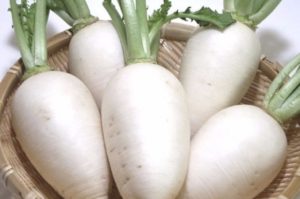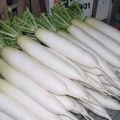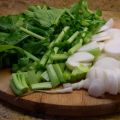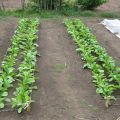Description of the daikon variety Misato Pink glitter, features of cultivation and care
Daikon Pink glitter belongs to the cruciferous family. Basically, it is a large Japanese radish with a delicate, sweet taste. This root vegetable reaches 10 centimeters in length. Its juicy, bright pink pulp will adorn any table.
Description of the variety
Daikon was bred by Japanese breeders. On the Islands of the Rising Sun, this vegetable has become one of the main ones in the diet. In addition to its taste, the variety attracts by the content of vitamins and minerals, which provide invaluable benefits to the body. On the territory of Russia, Misato's Pink Shine appeared several years ago, but has already gained popularity.
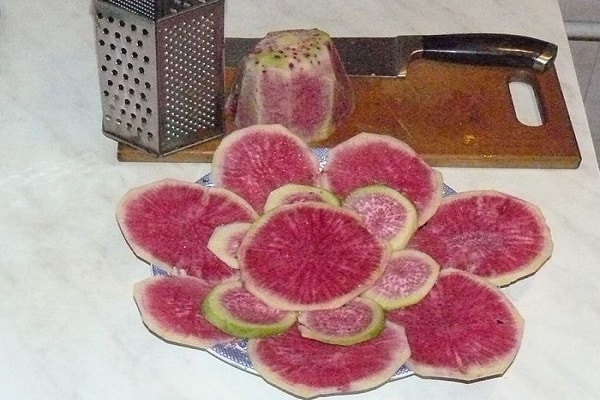
Daikon is a mid-season variety. Root crops have an even rounded shape, have excellent taste. The vegetable can be stored for a long time without losing its presentation. Since the variety is cold-resistant, it can remain in the ground until the first frost.
Japanese radish tolerates frosts well down to -5 degrees. But such an impact can negatively affect the taste and useful qualities of the vegetable, especially if it is stored in the future.
It is also worth noting that too high a temperature affects the roots even worse. At temperatures above 30 degrees, Japanese radish withers away. Its protective properties are reduced, and root crops are subject to increased attack by cruciferous fleas.

A characteristic feature of the daikon is the formation of a root crop already during the flowering period. It is a stable variety. Under optimal conditions, it produces even, uniform fruits.
Growing
Sowing the variety is recommended to be carried out in several terms, from mid-June to the end of July. On a bed whose width is 1 m or more, 2 rows are made. The seeds are planted to a depth of 3-5 centimeters, with 2-3 seeds in each hole. The distance between the holes is 30 centimeters. Daikon does not like shading and thickening.
It is recommended to carry out seed treatment before planting. Defective seedlings should be set aside. Good seeds should be placed in damp gauze before pecking, which will occur on the second day.
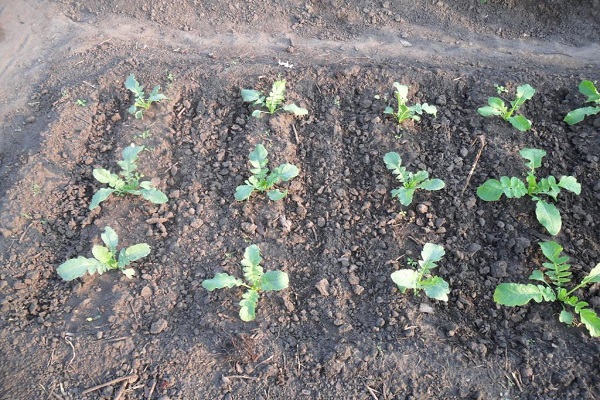
Good predecessors for Japanese radish are:
- salads;
- onion garlic;
- tomatoes;
- pepper;
- pumpkin;
- siderates.
The soil for Japanese radishes is prepared in the same way as for other vegetable crops, but with a deep digging of the earth. Root crops are more even on light soils and peat bogs. Heavy clay soil will also work, but it should be filled with humus or compost first.

If you grow a vegetable in an extended day, the formation of flowers will be reduced, while the development of root crops will decrease.Therefore, it is optimal to plant the variety in the second half of summer, when the length of the day is shortened to 13-15 hours. At this time, the best development of root crops falls.
The formation of the largest fruits occurs under intense exposure to sunlight. Growing conditions that are too tight can cause overgrowth of tops and stems.
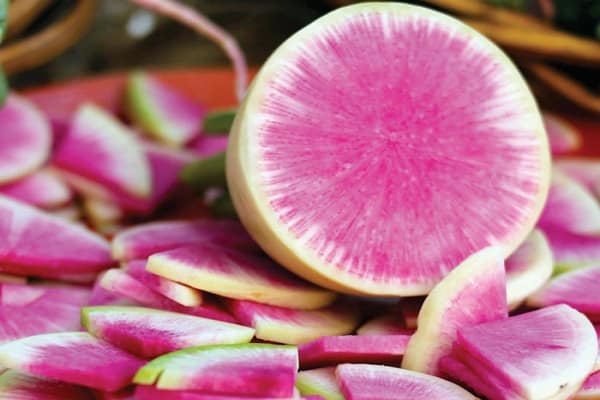
Care features
With sufficient moisture, the yield will be good. When flower arrows appear, try to break them. After one arrow is broken, they will appear with enviable regularity. Therefore, during this period, special attention is paid to the variety.
Non-flowering fruits, which receive enough nutrition and moisture, take 70 days to fully ripen. Root vegetables have a white skin with distinct red and green spots. They are almost completely submerged in the ground. The small part that protrudes above the ground turns green. Each root vegetable has a combination of pink and white, in some vegetables the shade thickens to beet red.
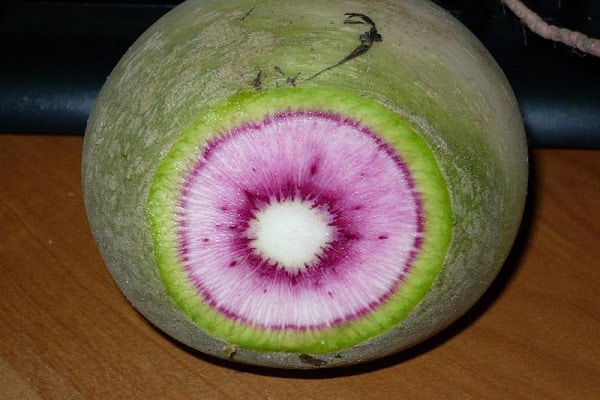
Daikon beds should be weeded and loosened regularly (2-3 times per season). In dry climates, the variety needs moderate watering. Waterlogging can cause mucous bacteriosis. If the soil is well seasoned, the Japanese radish need not be fed.
Note! Daikon can be planted deliberately late, but this will negatively affect the yield and storage of root crops.
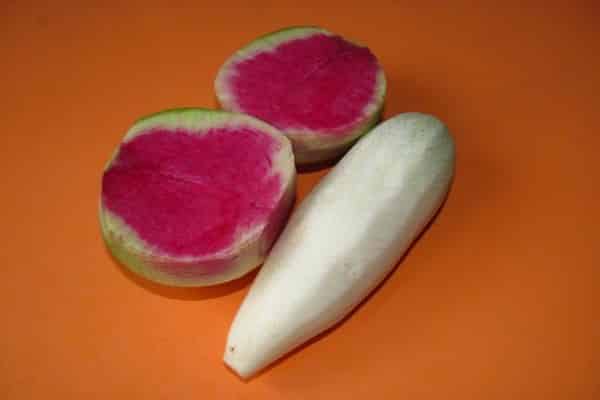
Advantages and disadvantages
The positive characteristics of daikon Misato Pink shine include:
- beautiful color, the vegetable will adorn any table;
- unpretentious cultivation, the variety does not need enhanced care;
- juiciness and delicate taste;
- good preservation of the variety.
Among the shortcomings, it is possible to note the different sizes of root crops with insufficient care. Also, the vegetable is unsuitable for multi-component salads, since it will simply get lost in them. Optimally cut the root vegetable into slices and garnish with herbs.

Pests and diseases
During the emergence of the crop, it is important to ensure that it is not harmed by the cruciferous flea. For this, seedlings can be treated with sifted ash with a mixture of tobacco (1: 1 ratio). Also, the crop can be damaged by the garden scoop, which reproduces in wet soil. This pest eats leaves and roots. To prevent this from happening, the seedlings should be watered with diluted potassium permanganate (a glass of solution in a bucket of water).
You can also treat the pests with hot red pepper. To do this, put 6-7 pieces of chilli peppers in a jar, pour hot water and leave for at least 12 hours. Then the infusion is diluted in 10 liters of water and the crop is watered. After 2-3 days, it is recommended to repeat the procedure, this will increase the chances of complete destruction of the pests.

To prevent slug infestation, small grooves are made around the plant beds and ash is poured. If the root crop is damaged by pests, it is not recommended to store and eat it.
Harvesting and storage
Harvest Japanese radish in dry weather. On heavy soils, it will have to be dug up with a shovel, on light soils - it pulls out by the tops without much difficulty.
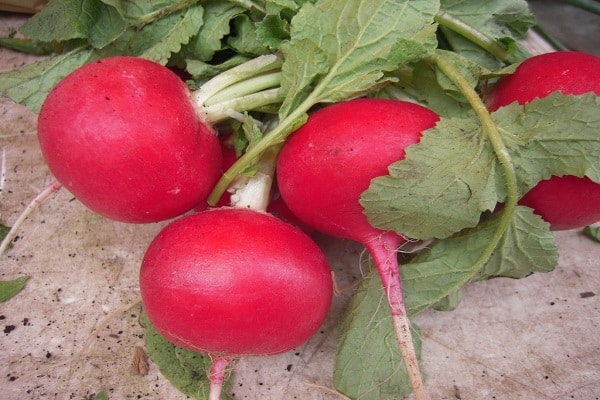
Daikon has one characteristic feature. If the root crop is damaged during harvesting, it will not be stored for a long time. Therefore, the harvest should be done with extreme care, and the damaged roots should be used first.
Although Japanese radish can be in the soil until the first frost, it is undesirable to overexpose it in the soil. This will negatively affect the taste of the vegetable. The optimal collection time is 60–70 days after the first shoots appear.

After extraction and soil, the root crop should be laid next to the ridges.Thus, the adhering earth will dry out, and the root crop can be easily cleaned of the soil.
Japanese radish can be stored for up to three months without losing its taste. If the roots are to be stored in the refrigerator, they must first be placed in plastic bags. Before that, you need to cut the tops.
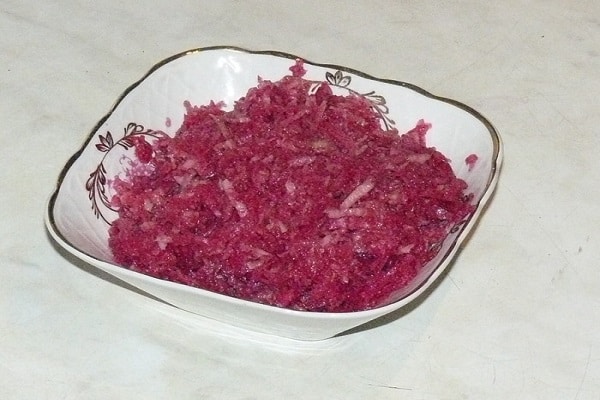
The ideal storage temperature for vegetables is 0 degrees. At low temperatures, it becomes glassy, at high temperatures, too soft.
Also, the storage place for Japanese radishes can be a cellar. In this case, the roots should be kept in boxes that are moistened with sand. Vegetables are stacked in rows, each layer is sprinkled with sand. The sand can be replaced with moistened moss.


